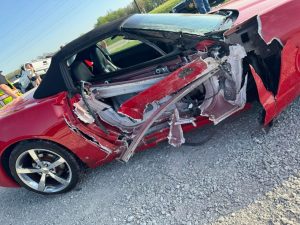Gibault grad lands dream job with Cardinals
When the Republic-Times learned that 2006 Gibault Catholic High School graduate Kevin Seats, who this spring received a Doctorate in Geophysics from Stanford University, had been hired by the St. Louis Cardinals, we wondered if this indicated the existence of a previously undetected gaping underground karst cave formation beneath Busch Stadium.
Seats swiftly reassured us that the stadium is on firm ground. Instead, Seats has been hired to bring his scientific, analytic skills to bear on the myriad of statistics that play increasingly important roles in modern sports decision making.
Although the Cahokia resident played on the soccer and bowling teams while at Gibault, he always put academics first. In fact, he obtained as many credits toward a college degree as he could while there.
“When I got to Saint Louis University, I found I could earn a degree in math in only two years. I realized I didn’t immediately know what I wanted to do after this time, so I quickly added physics and geophysics majors to fill out a full four years,” he told the Republic-Times in an interview at Busch Stadium on Friday.
Kevin Seats, a 2006 Gibault graduate, is a front office employee of the St. Louis Cardinals, bringing his analytic skills to statistics that are valuable in sports decision making.(Alan Dooley photo)
Kevin interned with the U.S. Geological Survey in Golden, Colo., while at SLU, where he developed an algorithm to aid in quickly identifying the difference between a natural seismic event (earthquake) and a large manmade explosion. This was of national importance, coming as it did in the 2008-09 time frame when North Korea was conducting its first nuclear tests.
He enrolled at Stanford in 2010 to pursue a PhD in geophysics. There, he embarked on a research project to develop advanced seismic imaging, or tomography. This is a method of mapping underground formations by analyzing sound and how it is affected as it travels through the ground.
While earthquake events create sound waves that scientists can use to learn about underground formations, it can be years between events and this makes them undependable for studying underground structures.
So, geologists often use explosives or impacts to generate sound waves. But Seats’ work while at Stanford aided in developing an imaging technique that requires only the ambient seismic noise, such as from weather or ocean waves, that make random squiggles on a seismogram.
He noted that science is advancing so swiftly, with increasingly sensitive instruments and powerful computers, that studies deemed impossible only a few years ago are being undertaken now.
“We could monitor earthquakes anywhere in the earth’s interior from an instrument on the infield of Busch Stadium,” he noted.
Seats said he spent considerable research time at Yellowstone National Park while at Stanford.
“While we were studying a known large magma chamber – or molten rock formation – under Yellowstone, we became aware of another one three times as large as the known one at the crust base,” he said.
As Seats approached graduation, he was confronted by the dilemma of where to go next.
“Oil and gas producers hire about half of the graduates. They make very good salaries, but, among the ones I know, they are often unsatisfied with the research they get to pursue,” he said.
The other path is research and academia.
“While I thought initially that I wanted to follow that route, I became increasingly aware of the bureaucracy and egos in the university world,” he continued.
Seats applied for post-doctoral, teaching and research positions, and even jobs in the petroleum industry.
“I had briefly worked on hockey analytics with a couple friends of mine. I really enjoyed the data analysis of it, and it opened my eyes to the world of sports analytics,” he said. “Then I learned the Chicago Cubs were seeking a person with math-analytic skills. Well, growing up in Cahokia, I idolized the Cards. So I wasn’t about to go to work for the Cubs.”
Seats emailed the St. Louis Cardinals.
“My wife Brittany – also a Gibault grad – said not to get my hopes up since I had only emailed the general info box,” Seats said. “But I will treasure forever the look on her face when I looked up from my laptop and told her, ‘I’ve got an email back from the Cards.’”
It was truly a career paradigm shift. Seats never dreamed of being offered the job.
Cardinals Assistant General Manager Michael Girsch had indeed nibbled at the bid. In the coming weeks, Seats flew to St. Louis for an interview.
“It was amazing, and on July 1, I became a St. Louis Cardinals front office employee. I still have to pinch myself,” he said as he looked around the empty stadium undergoing grounds upkeep.
Seats described his work without going into details. In bygone times, teams made decisions based on observations of experienced scouts and managers. Statistics were the numbers on the backs of baseball cards.
Today, teams dig deeply into observations to make decisions. Analytic numbers such as sabermetrics and other values are scrutinized to identify trends, talents and tendencies. The goal is to gain an advantage in knowing what’s occurring and will happen.
Seats did acknowledge computer power and math analysis skills are root requirements for his work.
“And I think the Cardinals have a unique, powerful blend of trust between experienced baseball scouts and those of us who analyze data. It’s a unique interface between the old and new schools,” Seats said. “My day job is a 9-to-5 task. But then I eat dinner at the stadium before a night game, after which I sit in the press box, watching, taking notes and yes, I admit – enjoying myself! I don’t know whether to say this – but it is still hard to believe I get paid for this,” Seats said, grinning. “I’m home – not just visiting!”
Seats credits his dad – his parents Dino and Dolores Seats still reside in Cahokia – with whetting and driving his math skills.
“He introduced me to binary numbers – a system that uses only 1’s and 0’s – with sugar packets in restaurants. And I have always been fiercely competitive. I absolutely hate to lose,” he said.
“My goal with the Cardinals? I want to help them win 162 games in a season.”
Seats obviously sees and pursues goals.
Concerning his wife, Brittany, “We started dating in eighth grade. She was my first love and is my greatest one today,” he affirmed.
Brittany is a project designer for the international firm DTZ Office Property Management.
Success is a family trait for the Seats. His brother Jason is a successful technology entrepreneur in Austin, Texas, and sister Cristina is a nurse.
Maybe it is easier to tell the way Seats’ work may be used than to describe how he does it.
Next time you see the Cardinals walk a specific batter, or you see an outfielder move to his left, or you see manager Mike Matheny spring from the dugout to change pitchers, it could be decisions stemming from the results of analytics.
For sure, it’s not coin flips or dumb luck. It may just be input from Seats at work.








